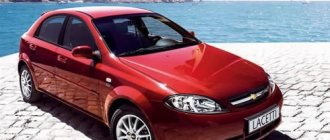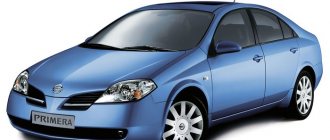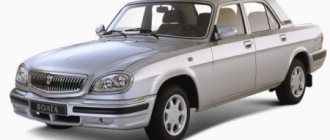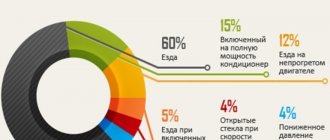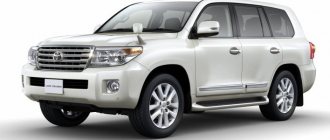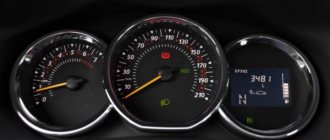First - Nissan Murano Z50
Produced from 2002 to 2008. It was equipped with two types of gasoline engines with an automatic transmission (variator), and was offered depending on the configuration with front-wheel drive and all-wheel drive.
Brief characteristics of engines and declared fuel consumption from the manufacturer
| Engine model | QR25DE | VQ35DE |
| Volume l. | 2.5 | 3.5 |
| Power hp | 163 | 249 |
| Fuel type | petrol | petrol |
| checkpoint | automatic | automatic |
| Acceleration to 100 | 10.5 | 8.9 |
| Fuel consumption, l: highway city mixed | 10 15 9.4 | 9.5 17.2 13.6 |
The fuel consumption of a Nissan Murano directly depends on the ratio of the car’s weight, engine size and driving style. Weight is 1640 kg. Real consumption exceeds the declared one by about 8-13%.
The QR25DE engine is a modernized QR20DE, in which a modified crankshaft with an increased piston stroke of 100 mm was installed, instead of the previous 80.3 mm. This technical solution made it possible to increase the volume to 2.5 liters without boring the cylinder block. But as a result of the work carried out, negative aspects appeared: the common problem of “oil wasting” and the service life of the engine decreased.
VQ35DE 3.5 l. Nissan's most popular engine, replacing the old 3-liter VQ30DE. The intake manifold, cylinder head, cylinder block, and timing belt were modified. Hydraulic compensators missing on the old model are installed.
Reasons for increased consumption
In owner reviews you can read that Nissan Murano consumes a lot of fuel. This is not entirely true, since for the 3.5 liter capacity with which the vast majority of these cars are equipped, the performance is quite adequate. The reasons for the increase in consumption lie in improper operation and poor technical condition of the car. Among these reasons, the main ones are:
- Untimely maintenance. During operation, the engine and electronics settings may become confused, and problems with the chassis and transmission may appear. It is necessary to change the oil and other consumables in a timely manner. All this negatively affects fuel consumption, dynamics and safety.
- Overloading the vehicle. When going on vacation or to the country house, you do not need to load the trunk of the car beyond the norm; this will negatively affect fuel consumption and the condition of the chassis.
- Smooth ride. At a speed of 120 km/h, consumption increases by 20%, similarly it increases with constant dynamic acceleration.
- Climatic features. Fuel consumption in severe frosts always increases, on average by 1 liter per hundred. In such cases, it is recommended to warm up the car before driving, since a cold engine under load consumes significantly more fuel. Be sure to change to winter tires.
- All Nissan Muranos are equipped with on-board computers that monitor fuel consumption in different driving modes. Each owner, analyzing their readings, can independently develop a list of rules to reduce gasoline or diesel consumption to minimum values.
Second generation - Murano Z51
Presented on the market from 2007 to 2021. The external design has been redesigned, more configuration options are presented compared to the first generation. Many additional, auxiliary electronic systems and sensors have been installed. The weight of the car has increased by 229 kg compared to the first generation.
From 2007-2010, Murano was equipped with a 3.5 liter gasoline engine, with an improved new generation CVT including all-wheel drive.
From 2010 to 2021, the company's designers carried out restyling in terms of changing the appearance and refining the interior.
Brief characteristics of the Z51 engine and consumption from the manufacturer
| Engine | VQ35DE |
| Volume l. | 3.5 |
| Power hp | 249 |
| Fuel type | petrol |
| checkpoint | automatic (new generation variator) |
| Acceleration to 100 | 8 |
| Fuel consumption, l: highway city mixed | 8.6 14.9 10.9 |
The VQ35DE has not undergone any changes. It is a complete analogue of the one installed on the Z50. The Z51 became more economical due to an improved transmission.
Interior
“Tidy” harmoniously fits into the rank of convenience. It is stylish and easy to read. Armchairs with many adjustments. Leather interior trim. The rear seats fold down and the floor surface becomes flat. The climate is understandable on an intuitive level.
The car warms up very quickly, even at 20 degrees below zero. Small things can be classified into different caches. For good music sound, the car is equipped with 6 speakers with a Bose subwoofer, with a standard JVC mechanism.
Luggage compartments in cars are large. There's room for a spare tire and a subwoofer that hides in the spare tire.
Third generation - Z52
Produced since 2014. In 2021, it began to be produced in Russia at a plant located in St. Petersburg. The third generation Nissan Murano is offered by the company with a 3.5 liter gasoline power plant and a 2.5 liter hybrid gasoline engine.
Brief characteristics of engines with declared consumption from the manufacturer
| Engine | VQ35DE | QR25DER |
| Volume l. | 3.5 | 2.5 |
| Power hp | 249 | 230-234 |
| Fuel type | petrol | petrol |
| checkpoint | automatic | automatic (redesigned CVT) |
| Acceleration to 100 | 7.9 (8.2) | 8.3 |
| Fuel consumption, l: highway city mixed | 8.6 14.9 9.9 (10.2) | 7 10.4 8.2 |
Real fuel consumption exceeds the rated fuel consumption by approximately 8-13%.
The engine of the QR25DER model is a combined one, combining a 2.5 liter engine and an electrical installation. The total power declared by the manufacturer is 254 hp, more than that of the favorite 3.5 liter engine. Using modern technologies and design solutions, the car turned out to be powerful and economical.
Nissan Murano is very popular in Russia due to its beautiful body, excellent build quality, high reliability, and good price-quality ratio.
Dismantling a car "piece by piece"
After reviewing the exterior, let's move inside and look at the technical characteristics of the car.
Let's start with the power unit. There is simply no choice of engines, only one option is available, but what is it - a 3.5 liter petrol six with a power of 245 hp. and 333 Nm of torque.
Just like with the engine, the buyer has no choice regarding the type of gearbox. Paired with the above-mentioned power plant is a continuously variable automatic transmission, referred to as a CVT.
The engine dynamics are impressive - the heavy crossover accelerates to hundreds in just 7.9 seconds. True, the process of gaining speed does not look so rapid, as it is smoothed out by the operation of the variator.
It is worth remembering that it is prone to overheating when driving for a long time in difficult conditions or when it is not cooled sufficiently, due to clogging of the air cooling system deflector.
Unlike a gearbox, the engine has proven itself to be quite reliable: having a timing chain drive, it may not require serious attention up to 250 thousand kilometers.
The suspension of the Nissan Murano is quite durable. The weak link in it is the anti-roll bars, which can last about 30 thousand km. The remaining components, with careful driving, will not remind you of themselves before 100 thousand.
Unfortunately, the braking system cannot boast of this, since it must effectively stop a fast and heavy car. In addition, brake discs, which are prone to warping, can be a surprise.
What is the real *fuel consumption of Nissan Murano*
According to official information, the passport data *fuel consumption of the Nissan Murano* is as follows: city 17.2 liters, highway 9.5 liters per 100 kilometers.
The situation can greatly change the operating conditions and the season of the year. In winter in city mode this figure approaches 22-23 liters, and an aggressive driving style can increase this figure even more.
Such fuel efficiency will not suit everyone, but you shouldn’t expect the fuel consumption of a small car from an engine of such power. As you know, you have to pay for pleasure, in this case you will have to do it at a gas station.
Owner reviews
Nissan Murano 2.5 (Z50)
Why Nissan? Because cars of this brand are much cheaper than their competitors - Toyota, Honda, Subaru, Mitsubishi. Sometimes even 100 rubles, but cheaper and at the same time also 2-5 years younger. Nissan designers are simply wizards. We worked on this body for a long time. It looks like a spaceship on the date the car left the production line. It was made massive, recognizable, with its own individuality. Subsequent bodies are somehow slicked down, similar to competitors. But not the Z50! It stands out on the road and doesn't look like it belongs in its class. For 2003, I’m sure this was a challenge and it paid off. He had no equal on the road. I don’t monitor my gas consumption, I’m happy with everything.
Z50 3.5
Don't believe anyone who says Nissan is not a reliable car. I have owned the car since 2008 and drive it every day. The Nissan Murano is a reliable car, whether for daily driving or long-distance driving. The 3.5 liter engine has 9 liters of fuel consumption on the highway. Soft and comfortable crossover. It does not cost exorbitant amounts of money to maintain. Anyone who is thinking about buying a car - take it and don’t think twice, you won’t regret it. The CVT gearbox does not like sudden movements from a standstill. But as soon as you let the car move a little and press the pedal, the car accelerates very pleasantly.
Murano Z51
Additionally, I installed lights for the state. number, since Murano suffers in terms of optics. During operation, nothing critical happened to the car, with the exception of the generator (replaced). I served mainly at Union Motors, which specializes only in Nissans. In general, the car is what you need, and the reliability of the car is 5 out of 5. Having owned the Murano for 3 years and 4 months, I have not experienced any problems. I don’t particularly monitor fuel consumption, because... When buying a car I was ready for any expense. Only the reverse gear broke and the gearbox was completely rebuilt, now you can easily go at least 150 (under normal use).
Z52 3.5
I have been driving Nissan cars for over 25 years. This is a long time to understand that I am completely satisfied with this brand. And such an aspect as the price-quality ratio generally justifies itself. For example, I already have my second Nissan Murano. I drove the previous one for 4 years and only changed consumables. The car is comfortable, everything is good in terms of interior and ergonomics. Finally, the Japanese have made this model a heated wiper area and a heated steering wheel in winter. The mileage in 7 months is just over 9 thousand km. Fuel consumption in the city is about 17 liters, but here you are constantly stuck in traffic jams. The car smells nice, the decoration is rich and the quality of materials is high. The car is very strong. The engine is a good old naturally aspirated engine and seems to be quite powerful by today’s standards. The updated variator, in my opinion, began to work more clearly, because The function of simulating speed switching has been added. The trunk is still roomy. There is plenty of room for passengers in the back.
Valid fuel consumption data
The most powerful engine, relative to its predecessors, increases fuel costs for the Nissan Murano by almost 1.5 times. Country driving will cost 11-12 liters, and in the city about 20 liters per 100 km. Such “appetites” of the engine outrage more than one owner of a Nissan car of this model.
Methods to reduce fuel costs
Having studied the official data of the company and real figures, it should be noted that fuel consumption on the Nissan Murano is high and we need to look for possible options to reduce fuel costs. First of all, you need:
- timely diagnostics of all engine systems;
- monitoring the thermostat and coolant temperature sensor;
- refueling your car with high-quality gasoline at proven gas stations;
- moderate and non-aggressive driving style;
- smooth braking.
In winter, it is especially important to comply with all standards, otherwise the overspending on the Nissan Murano will be huge. Therefore, it is necessary to warm up the engine prematurely, especially in severe frosts, so that it does not heat up while driving and, accordingly, does not consume excess fuel.
If you follow these rules, you can significantly reduce the gasoline consumption of the Nissan Murano crossover.
Other problems and malfunctions
With age, corrosion actively develops on the rear wheel arches (under the door seal). In addition, rust can be found on the shock absorber support cup, which can rot into holes.
Water in the cabin may appear due to a clogged sunroof drain.
After 250,000 km, the door and trunk locks begin to fail (3-7 thousand rubles per lock). In most cases, you can get away with replacing the servo motor (from 100 rubles)
The generator was not very durable either.
The exhaust system resonator hangs too low, which is why it often gets damaged and requires replacement (1000 rubles for an analogue).
